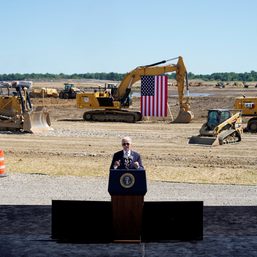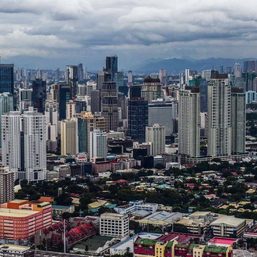SUMMARY
This is AI generated summarization, which may have errors. For context, always refer to the full article.
![[In This Economy] Looks like PH economy will never get back on track. Here’s the data.](https://www.rappler.com/tachyon/2024/02/20240202-PH-economy-back-on-track.jpg)
For 2023, the Marcos administration aimed for economic growth between 6 and 7%.
But on January 31, the government reported that actual growth fell below that target, at just 5.6%. (Incidentally, the growth rate for the last quarter of 2023 was also 5.6%.)
Sure, that means our economy still expanded relative to 2022. But it certainly could have grown faster.
Figure 1 shows that there seems to be a downward trajectory of growth. The 5.6% in the fourth quarter is also lower than pre-pandemic times, when we came to expect at least 6% each quarter.
Figure 1.
Growing at 5.6% also means that we may be locked in on a permanently lower growth path. That is, we will never get back to the pre-pandemic trajectory of total production.
Figure 2 shows that we need 10.3% growth per year if we want to go back to the pre-pandemic trajectory by 2028.
If, starting now, we just grow by 5.6% yearly, we will end up on the purple trend which is permanently below the yellow pre-pandemic trend.
Figure 2.
Government officials like to say that 5.6% makes us the fastest-growing country in this part of the world. That’s only true if you look at the annual data. But Figure 3 shows that Vietnam’s quarterly growth is steadily rising and reached 6.72% in the last quarter of 2023. That’s a lot higher than our 5.6%. We’re not quite number one.
Figure 3.
Losing steam
In the post-pandemic world, the Philippine economy is supposedly bouncing back. And we sort of did, in 2021 and 2022. But in 2023, we lost steam.
Figure 4 shows that consumption, our biggest growth driver, has slowed down. The culprit is food spending growth, which essentially evaporated in 2023. This is likely due to the spell of high inflation since 2022: if prices are too high, Filipinos will think twice before buying a lot of foodstuff in palengkes or markets.
Figure 4.
Investment spending also weakened a lot, particularly construction activities by households and corporations. This may have something to do with the elevated interest rates set by the Bangko Sentral ng Pilipinas or BSP (as a way to temper inflation). Higher interest rates are like a chokehold on the economy; they make it costlier to finance new investments like construction projects.
This is why many analysts are closely watching the BSP’s next moves, and eagerly awaiting the day when interest rates will drop again.
Another thing that weakened is government spending other than construction. Figure 5 shows that it all but vanished in 2023: out of 5.6% total growth, government spending contributed only 0.05 percentage point.
How come? Doesn’t the government enjoy a larger budget every year?
Well, inflation also tends to eat away at the nominal budget of government. And slower public spending may have something to do with weak obligation and disbursement rates across agencies. In short, even agencies are having a hard time spending money, due to, say, procurement rules and regulations and lack of enough people to handle projects. That’s a perennial problem of government that lingers to this day.
Figure 5.
Weaker sectors
Weak economic growth is also mirrored by the data coming from the different sectors of our economy, namely agriculture, industry, and services.
Figure 6 showed that services, the biggest sectoral growth driver, slowed down a lot from 2022 to 2023. This is on account of weaker production in trade, transportation and storage, information and communication, and professional and business services. (One thing that’s growing again is financial and insurance services.)
Figure 6.
Industrial growth also faltered, thanks to weaker construction growth and, more crucially, weaker manufacturing growth. By end of 2023, manufacturing contributed just 0.35 percentage point to the 6.33% industrial output growth. Pitiful!
Agriculture, as always, contributed nearly nothing in 2023. Out of 5.6% yearly growth, agriculture accounted for just 0.1 percentage point. This isn’t exactly new. There’s still a lot to do so we can improve agricultural productivity.
Clearly, we need to fire up our sectors once again. But how?
The Marcos administration likes to point to the lack of investments, particularly foreign investments, in sectors like manufacturing. They even use this to justify moves to amend the 1987 Constitution and remove the supposedly restrictive economic provisions. But as I wrote last week, that’s a misleading narrative.
Moonshot
This is the first time that the Marcos government missed its annual growth targets.
Do you recall President Ferdinand Marcos Jr.’s first State of the Nation Address? He said there that GDP growth is targeted to fall between 6.5% and 7.5% in 2022. Actual growth for 2022, which clocked in at 7.6%, exceeded the target. They even touted that as the fastest growth rate in 46 years!
While true, I offered some important caveats. For instance, that high growth reflects base effects (we were coming from such a low place in 2021) and revenge spending (people were cooped up in their houses for too long and wanted to go out and spend).
In 2023, data show that both base effects and revenge spending seem to have dissipated. So we’re finally getting a truer picture of economic activity post-pandemic.
In Marcos’ 2022 SONA, he said that the government expects economic growth to fall between 6.5% and 8% yearly from 2023 to the end of his term in 2028.
With the new 2023 data, that projection now sounds like a moonshot. Let’s learn to manage our expectations in the coming years. – Rappler.com
JC Punongbayan, PhD is an assistant professor at the UP School of Economics and the author of False Nostalgia: The Marcos “Golden Age” Myths and How to Debunk Them. JC’s views are independent of his affiliations. Follow him on Twitter (@jcpunongbayan) and Usapang Econ Podcast.
1 comment
How does this make you feel?
![[In This Economy] Marcos’ POGO ban is popular, but will it work?](https://www.rappler.com/tachyon/2024/07/thought-leaders-marcos-pogo-ban.jpg?resize=257%2C257&crop=255px%2C0px%2C720px%2C720px)
![[Rappler Investigates] POGOs no-go as Typhoon Carina exits](https://www.rappler.com/tachyon/2024/07/newsletter-graphics-carina-pogo.jpg?resize=257%2C257&crop=424px%2C0px%2C1080px%2C1080px)



![[ANALYSIS] Why do we pay higher power rates when we have power outages?](https://www.rappler.com/tachyon/2024/07/tl-higher-power-rates-higher-power-outages.jpg?resize=257%2C257&crop=401px%2C0px%2C1080px%2C1080px)
![[Vantage Point] Philippine economic reforms run into headwinds](https://www.rappler.com/tachyon/2024/05/ph-economic-headwind-may-2024.jpg?resize=257%2C257&crop_strategy=attention)
![[ANALYSIS] Promoting PPP via a sufficiently empowered media](https://www.rappler.com/tachyon/2024/04/PPP-and-media.jpg?resize=257%2C257&crop=365px%2C0px%2C720px%2C720px)
![[In This Economy] Here’s a new paper by UP economists on economic charter change](https://www.rappler.com/tachyon/2024/04/TL-foreign-direct-investments-apr-12-2024.jpg?resize=257%2C257&crop=299px%2C0px%2C720px%2C720px)











![[Just Saying] SONA 2024: Some disturbing points](https://www.rappler.com/tachyon/2024/07/TL-marcos-sona-points-july-23-2024.jpg?resize=257%2C257&crop=335px%2C0px%2C720px%2C720px)






![[In This Economy] Is the Philippine economy stable?](https://www.rappler.com/tachyon/2024/05/philippine-economy-stable-may-10-2024.jpg?resize=257%2C257&crop=461px%2C0px%2C1080px%2C1080px)


![[In This Economy] Is the Philippines quietly getting richer?](https://www.rappler.com/tachyon/2024/04/20240426-Philippines-quietly-getting-richer.jpg?resize=257%2C257&crop=194px%2C0px%2C720px%2C720px)
![[Vantage Point] Joey Salceda says 8% GDP growth attainable](https://www.rappler.com/tachyon/2024/04/tl-salceda-gdp-growth-04192024.jpg?resize=257%2C257&crop_strategy=attention)
Thanks to Prof. JC Punongbayan for another enlightening (but depressing) economic article. Noted: “… even agencies are having a hard time spending money, due to, say, procurement rules and regulations and lack of enough people to handle projects. That’s a perennial problem of government that lingers to this day.” These are the probable causes: 1) when procurement rules and regulations make it HARDER for corrupt politicians to get the People’s money; 2) on lack of enough people …: when businesspersons think that corruption cannot give them the “reasonable” profit they deserve or acceptable calculated risk that they are willing to take.